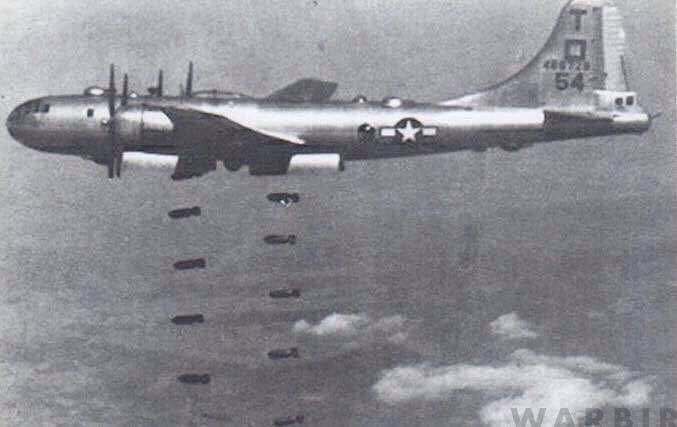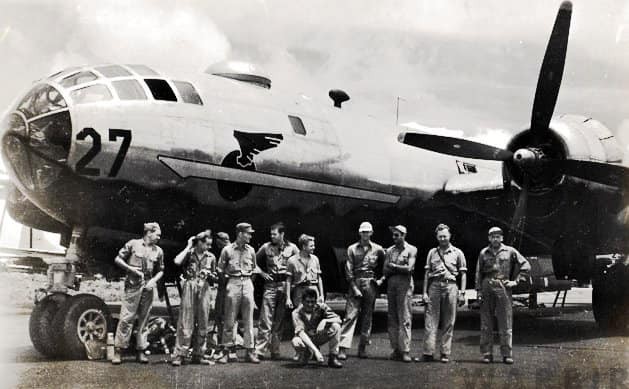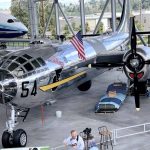Since his childhood, Randy Malmstrom has had a passion for aviation history and historic military aircraft in particular. He has a particular penchant for documenting specific airframes with a highly detailed series of walk-around images and an in-depth exploration of their history, which have proved to be popular with many of those who have seen them, and we thought our readers would be equally fascinated too. If Randy’s last name seems familiar, it is because the U.S. Air Force’s present-day Malmstrom AFB, near Great Falls, Montana is named in honor of his cousin, Col Einar Axel Malmstrom. Col Malmstrom commanded the 356th Fighter Group during WWII, flying P-47 Thunderbolts, the first of Randy’s articles featured an example of the type, P-47D 45-49406 at the presently-shuttered Flying Heritage & Combat Armor Museum in Everett, Washington.
For the second article of this series, we have chosen the Museum of Flight‘s combat-veteran Boeing B-29 Superfortress 44-69729, which flew bombing missions during WWII with the 875th Bombardment Squadron (BS) of the 498th Bombardment Group (BG). After the war, the bomber underwent conversion into an aerial refueling tanker, but was eventually relegated to the China Lake Naval Gunnery Range in California, where it remained until rescued by a team from Lowry Air Force Base (AFB) in 1986. When Lowry closed in 1994, the aircraft moved to the Museum of Flight in Seattle, Washington, on loan from the National Museum of the United States Air Force in Dayton, Ohio.
Boeing B-29-60-BW, “T-Square 54” s/n 44-69729, c/n 10561
by Randy Malmstrom
Boeing B-29-60-BW, “T-Square 54” s/n 44-69729, c/n 10561: The Boeing Aircraft Company’s plant in Wichita, Kansa built this particular aircraft, delivering it to the U.S. Army Air Forces in 1944. As Aircraft #739, it flew 37 combat missions over Japanese mainland targets during World War II with the U.S. Army Air Forces’ 20th Air Force, 73rd Bombardment Wing, 875th BS, 498th BG stationed at Isley Field on the Western Pacific island of Saipan. According to Wallace Van Eaton, one of this aircraft’s copilots (he and his crew flew five of the aircraft’s WWII combat missions), it was a backup plane and never assigned to any specific crew. As a result, the aircraft never received a name or distinctive nose art. The name T-Square 54 simply refers to the identification insignia on the aircraft’s tail: the T represents the specific bombardment group, the square its bomb wing, and the number 54 is the plane-in-group number.
Consequently, the nose art which the restored aircraft presently sports is not what it would have worn during its service life – it is simply just the 73rd BW’s “Ball and Spear” insignia. In 1950, the Air Force had ‘729 converted into a KB-29M aerial refueling tanker; it served with the 55th Air Refueling Squadron, a part of the 2nd Tactical Air Force’s Strategic Reconnaissance Group (SRG) based at Ramey AFB in Aguadilla, Puerto Rico. During this period, the B-29 wore nose art on the right side with the name Tillie the Tanker. This unit’s aircraft had blue and white diagonals on top of the tail fin, nose wheel doors, and wingtips, while the tail also had a hollow black square (denoting the 2nd Air Force) with a black V within it (denoting the 55th SRG). The livery also included a black speed stripe running the length of the fuselage on both sides.
The 55th SRG returned to the U.S. in October of 1952, moving to Forbes AFB in Topeka, Kansas, redesignated as the 55th Strategic Reconnaissance Wing (SRW) of the 15th Air Force (the hollow black square on the tail was replaced by a hollow black circle with a V within it denoting the 55th SRW). In February 1954, the 55th SRW moved to Lincoln AFB in Lincoln, Nebraska, where the unit became inactivated. By 1956, the US Air Force struck the aircraft from its inventory and sent it to China Lake Naval Air Weapons Station in California for use as a ground crew test target. However, in 1986 the Lowry Heritage Museum at Lowry AFB near Denver, Colorado acquired the airframe. They contracted Mel Blanscette of Ogden, Utah, and his crew of volunteers who became known as “Mel’s Misfits” to restore the aircraft to its 1944 configuration (including its tail code). They rededicated the aircraft on October 2, 1987, Lowry’s 50th anniversary. However, Lowry AFB closed in 1994, and so the aircraft needed a new home.
In 1995, the National Museum of the U.S. Air Force placed the aircraft on loan to the Museum of Flight (MOF) in Seattle, Washington. The bomber went through extensive restoration effort and is now on static display in the MOF’s Aviation Pavillion. The museum’s restoration was pretty comprehensive, including making each of the gun turrets operational, albeit with de-militarized weapons. However, as of this writing, the aircraft is missing starter spline adaptors on its engines, with the 36 wire ignition spark plug wires literally cut, nor does the aircraft have fuel cells installed. The bomb bay doors are not original and open but are not actuated. The National Museum of the United States Air Force does not allow its aircraft to be flown, so returning the B-29 to flight is not up to the discretion of the MOF.
The images in this article are mostly my own, but with some courtesy of Don England and Chris Wall – many thanks, to them both! The clip below is a brief view inside the cockpit which I created, and thought readers might find interesting.
While most will recognize that the B-29’s name, Superfortress, clearly derives from Boeing’s earlier long-range, strategic bomber, the B-17 Flying Fortress, a fair few may not realize that the B-17 gained it’s own nickname from a photo caption which the Seattle Times reporter (and editor) Richard L. Williams wrote in describing the type’s progenitor, the Boeing Model 299, at its rollout on July 17, 1935.
Boeing began working on the design for the aircraft which became the B-29 in 1938, but the type endured many teething problems, as did the Wright R-3350 engines which powered it. As a result, production variants did not see combat until June, 1944. The type’s initial combat operations started in the China-Burma-India Theatre, but the B-29 is far more well known for its ultra-long-range operations over the Japanese mainland, launched from postage stamp-sized islands in the Pacific Ocean. Interestingly, two B-29s did fly to Europe late in the war, but these aircraft did not take part in combat operations there. In 1946, my father was a USAAF corporal based at Y-80 Air Base in Wiesbaden, Germany, and I remember him speaking of these B-29s, specifically mentioning flights he had made in them over Düsseldorf and Strasbourg with Capt. Wickey, as well as flights he was not on to Cairo, and a search mission over the Alps flown by Col. F.G. Pinnegar (my father had corresponded with him in Sacramento in 1997).
The B-29 was the first American production bomber to have pressurized crew compartments: forward, aft, and tail gunner positions, with a pressurized connecting tunnel over the bomb bays. The cockpit was referred to colloquially as the “greenhouse”, for obvious reasons.
The following relates to how flight controls were handled and comes loosely from the USAAF Training Manual: The Aircraft Commander/Pilot coordinates all startup actions – indeed, the B-29 is considered as the first airplane to institute a formal call and response checklist as standard procedure. This is worked between the Aircraft Commander/Pilot, Copilot, and Flight Engineer. The Flight Engineer handles engine start and warm-up. When taxiing, the Pilot has throttle control. Before takeoff, the Pilots and Flight Engineer check the prop master controls and generators, and the Flight Engineer performs the magneto checks. The turbo-supercharger master is set to the takeoff position, and each engine is run up to takeoff power. For takeoff, the Pilot is running the throttles. Directional control at low speeds is effectuated using differential thrust – using the brakes should be avoided. After takeoff, the Pilot in Command calls for “Power Condition 2” (climb power). The Copilot adjusts the prop RPM with the master control and controls the manifold pressure with the master turbo-supercharger regulator. The Flight Engineer is monitoring cylinder head temperatures, and adjusting cowl flaps and, if necessary, power, to keep them within limits. The Flight Engineer controls power settings in cruise, using the charts in the handbook to producing the most efficient combination of RPM/manifold pressure/mixture/cowl flap position to maintain cruise conditions of altitude and airspeed. When landing, the pilots take primary control of the engines. Shutdown procedures are handled by the Flight Engineer.
The type was incredibly innovative for its use of a remote-controlled, gun-sighting system guided by an analog computer. Except for the tail position, the aircraft’s gunners no longer sat in turrets, but rather at ‘sighting stations’ using a remote periscope sighting system for the turrets which had switches to obtain or relinquish control of the four turrets; the top turret gunner/central fire control officer had switches for changing control as to which gunner was on the target depending on his field of view; the gunners communicated via the interphone system. The bombardier was generally responsible for the forward dorsal 4-gun turret and the forward ventral 2-gun turret for frontal attacks. Armament in this aircraft includes: twin-mounted General Electric .50 caliber machine guns in remote-controlled forward and rear ventral turrets and a ventral rear aft turret, and quad-mounted .50 cal. in a remote-controlled forward dorsal turret, and pair in the tail turret (armament varied in these aircraft , with some having a 20 mm cannon was added to the tail turret). Typically each crew had ten men, or eleven when radar was used, and these consisted of: Aircraft Commander (pilot), co-pilot, bombardier, flight engineer, radio operator, navigator, right gunner, left gunner, top gunner/central fire control officer, tail gunner, (and radar operator). The top gunner sat in a pedestal seat nicknamed the “Barber’s Seat.” Due to the B-29’s complexity, the flight engineer (who sat facing aft behind the co-pilot) had an essential role in flying the aircraft; he was responsible for the minute-by-minute monitoring and control of the engines. Each crew position was fitted with a 1936 Ford ashtray. The aircraft could carry a wide range of ordinance in its large forward bomb bay and its smaller one to the aft.
The B-29 is, of course, best known for it’s role as a strategic nuclear bomber, the type having dropped atomic bombs on Hiroshima and Nagasaki (a secondary target chosen due to poor visibility over the primary target of Kokura). In 1946, the U.S. Army Air Forces formed the Strategic Air Command (SAC), the B-29 forming the initial backbone of its heavy bomber force. Interestingly, it had an almost identical counterpart in the Soviet Union’s arsenal, the Tupolev Tu-4, which was virtually a bolt-for-bolt copy of the Superfortress, reverse-engineered from a handful of B-29s which had come down over that nation’s territory during WWII. The Tu-4, NATO codename “Bull”, saw large scale production and wide use into the 1960s, and the type had many iterations. Indeed, the Soviet Union’s primary strategic bomber throughout much of the Cold War, the Tu-95, owes its roots to the Tu-4. The Chinese also fielded several Tu-4s and their derivatives in various roles, with the last of these not retiring until 1988!
But Britain’s Royal Air Force was the only Western nation outside of the USA to fly B-29s at squadron strength. They borrowed roughly a hundred examples, which they named the Washington. They served between 1950 and 1958 as a stopgap heavy bomber while next-generation jet bombers, such as the Avro Vulcan underwent production development. Meanwhile back in the USA, B-29s were superseded relatively quickly in SAC by the Boeing B-50 (developed from the B-29D), and then the B-36 and B-47 soon after that. B-29s did see considerable action with the U.S. Air Force during the Korean War, of course, but its days as a long-range heavy bomber pretty much ended once that conflict wound down. A few of them lingered on in specialized, non-combat roles into the late 1950s, but the last of these aircraft had retired by 1960.
About Randy Malmstrom





































